Financial Analysis: Cost Concepts and Activity-Based Costing in ABB
VerifiedAdded on 2023/05/29
|8
|1719
|375
Report
AI Summary
This report provides an in-depth analysis of ABB Limited's application of various cost concepts, with a particular focus on activity-based costing (ABC). It begins by outlining the history and operational structure of ABB Limited, highlighting its global presence and key divisions. The report details how ABB Limited utilizes activity-based costing to calculate the historical cost of products and services, comparing these results with traditional costing methods to identify significant differences and inform future budgets. It assesses the appropriateness of ABC for ABB, emphasizing its role in providing managers with valuable insights for financial decision-making, resource allocation, and process improvement. Furthermore, the report discusses several cost concepts, including historical cost, opportunity cost, actual costs, business costs, full costs, explicit costs, out-of-pocket costs, fixed costs, and total costs, referencing ABB Limited's 2017 annual report to illustrate these concepts with real-world examples. The analysis concludes that activity-based costing is well-suited to ABB Limited's needs, enabling better cost management and strategic decision-making.
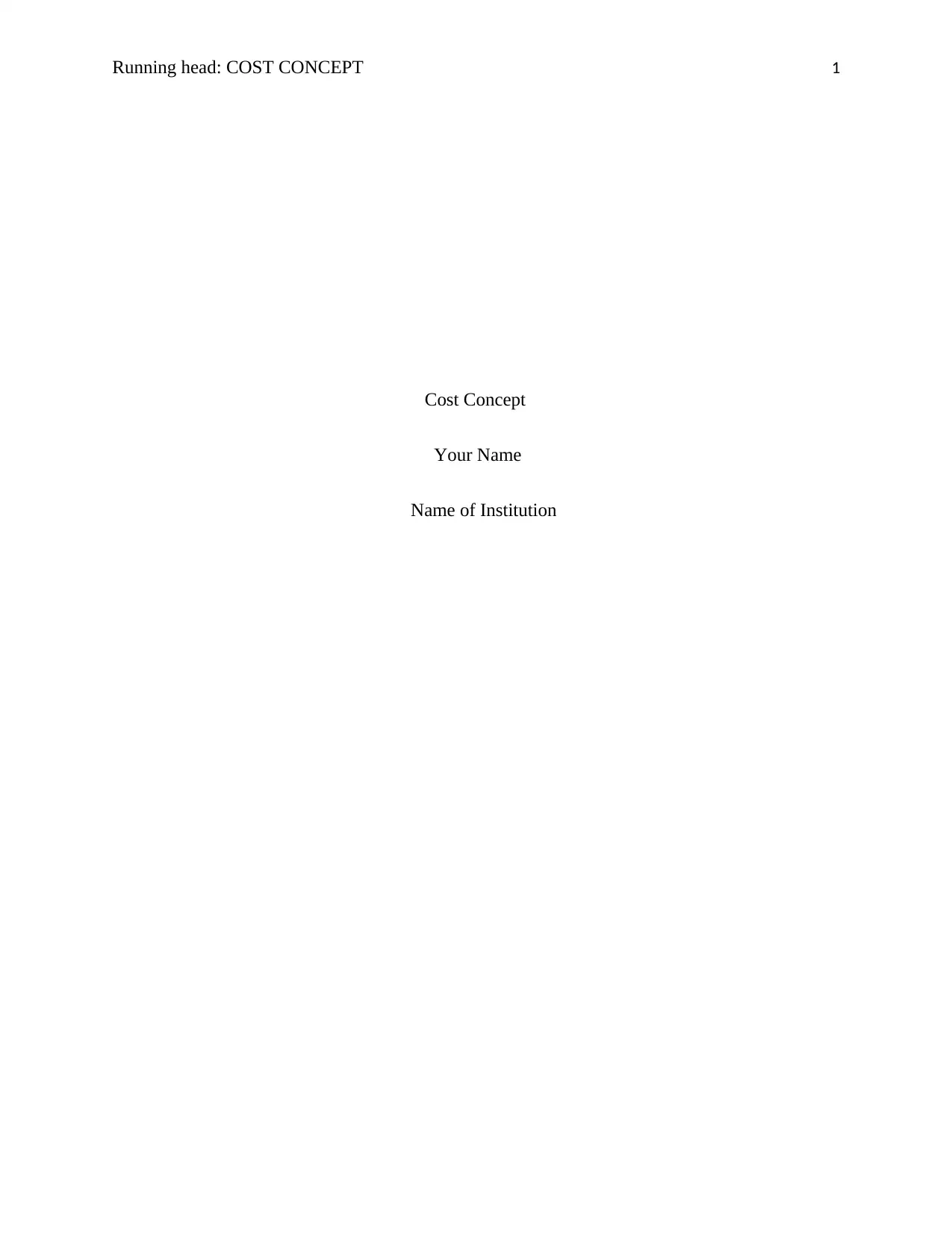
Running head: COST CONCEPT 1
Cost Concept
Your Name
Name of Institution
Cost Concept
Your Name
Name of Institution
Paraphrase This Document
Need a fresh take? Get an instant paraphrase of this document with our AI Paraphraser
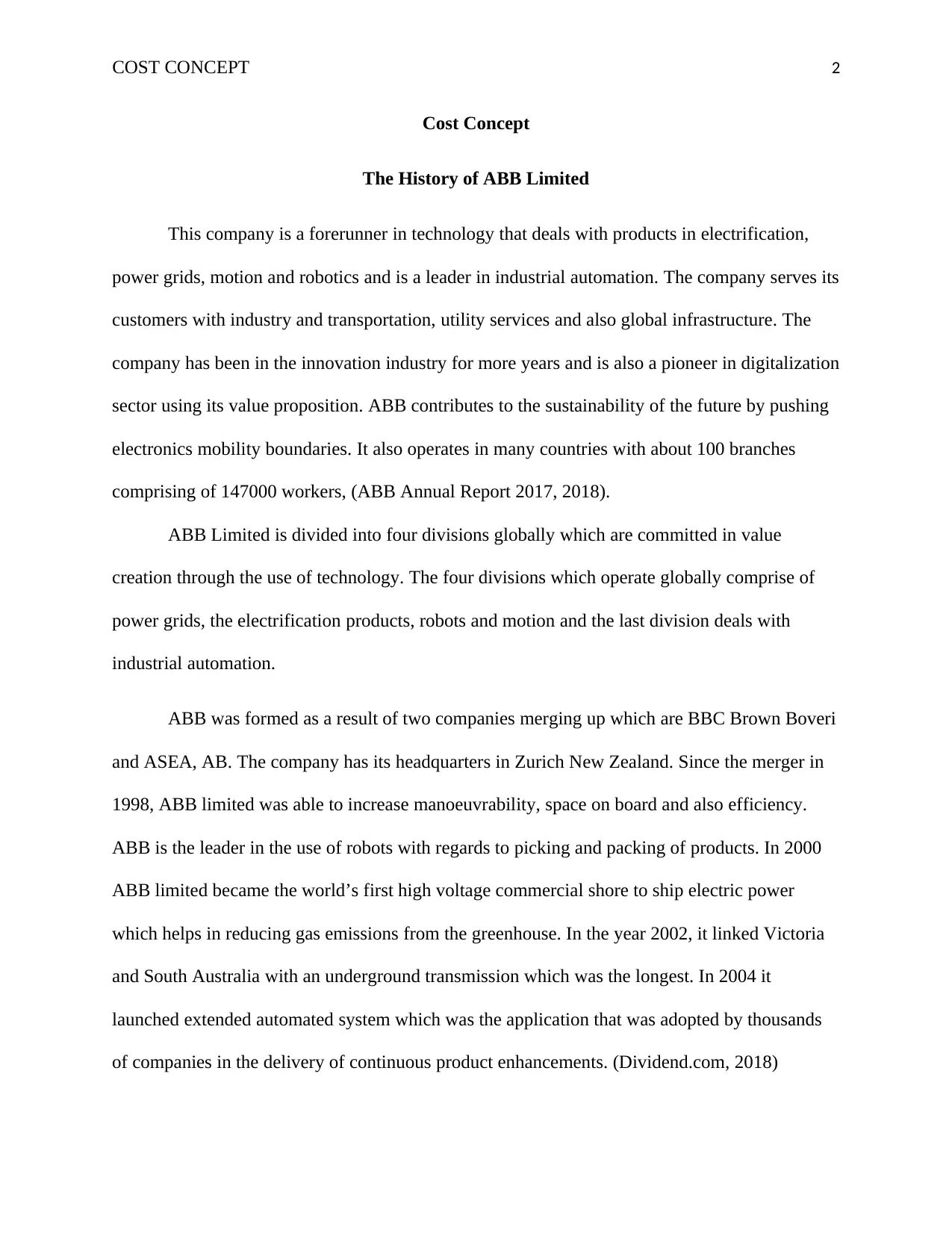
COST CONCEPT 2
Cost Concept
The History of ABB Limited
This company is a forerunner in technology that deals with products in electrification,
power grids, motion and robotics and is a leader in industrial automation. The company serves its
customers with industry and transportation, utility services and also global infrastructure. The
company has been in the innovation industry for more years and is also a pioneer in digitalization
sector using its value proposition. ABB contributes to the sustainability of the future by pushing
electronics mobility boundaries. It also operates in many countries with about 100 branches
comprising of 147000 workers, (ABB Annual Report 2017, 2018).
ABB Limited is divided into four divisions globally which are committed in value
creation through the use of technology. The four divisions which operate globally comprise of
power grids, the electrification products, robots and motion and the last division deals with
industrial automation.
ABB was formed as a result of two companies merging up which are BBC Brown Boveri
and ASEA, AB. The company has its headquarters in Zurich New Zealand. Since the merger in
1998, ABB limited was able to increase manoeuvrability, space on board and also efficiency.
ABB is the leader in the use of robots with regards to picking and packing of products. In 2000
ABB limited became the world’s first high voltage commercial shore to ship electric power
which helps in reducing gas emissions from the greenhouse. In the year 2002, it linked Victoria
and South Australia with an underground transmission which was the longest. In 2004 it
launched extended automated system which was the application that was adopted by thousands
of companies in the delivery of continuous product enhancements. (Dividend.com, 2018)
Cost Concept
The History of ABB Limited
This company is a forerunner in technology that deals with products in electrification,
power grids, motion and robotics and is a leader in industrial automation. The company serves its
customers with industry and transportation, utility services and also global infrastructure. The
company has been in the innovation industry for more years and is also a pioneer in digitalization
sector using its value proposition. ABB contributes to the sustainability of the future by pushing
electronics mobility boundaries. It also operates in many countries with about 100 branches
comprising of 147000 workers, (ABB Annual Report 2017, 2018).
ABB Limited is divided into four divisions globally which are committed in value
creation through the use of technology. The four divisions which operate globally comprise of
power grids, the electrification products, robots and motion and the last division deals with
industrial automation.
ABB was formed as a result of two companies merging up which are BBC Brown Boveri
and ASEA, AB. The company has its headquarters in Zurich New Zealand. Since the merger in
1998, ABB limited was able to increase manoeuvrability, space on board and also efficiency.
ABB is the leader in the use of robots with regards to picking and packing of products. In 2000
ABB limited became the world’s first high voltage commercial shore to ship electric power
which helps in reducing gas emissions from the greenhouse. In the year 2002, it linked Victoria
and South Australia with an underground transmission which was the longest. In 2004 it
launched extended automated system which was the application that was adopted by thousands
of companies in the delivery of continuous product enhancements. (Dividend.com, 2018)
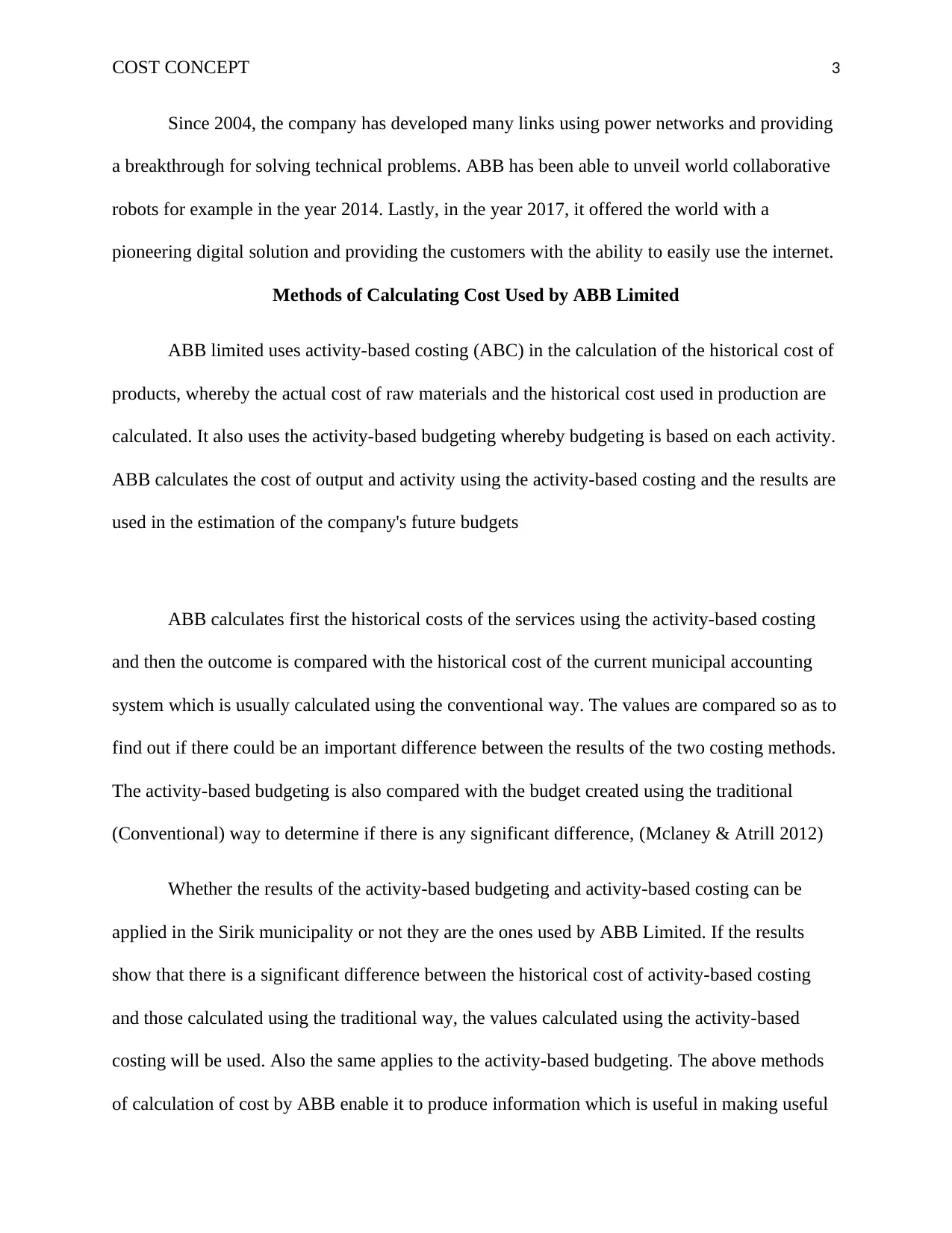
COST CONCEPT 3
Since 2004, the company has developed many links using power networks and providing
a breakthrough for solving technical problems. ABB has been able to unveil world collaborative
robots for example in the year 2014. Lastly, in the year 2017, it offered the world with a
pioneering digital solution and providing the customers with the ability to easily use the internet.
Methods of Calculating Cost Used by ABB Limited
ABB limited uses activity-based costing (ABC) in the calculation of the historical cost of
products, whereby the actual cost of raw materials and the historical cost used in production are
calculated. It also uses the activity-based budgeting whereby budgeting is based on each activity.
ABB calculates the cost of output and activity using the activity-based costing and the results are
used in the estimation of the company's future budgets
ABB calculates first the historical costs of the services using the activity-based costing
and then the outcome is compared with the historical cost of the current municipal accounting
system which is usually calculated using the conventional way. The values are compared so as to
find out if there could be an important difference between the results of the two costing methods.
The activity-based budgeting is also compared with the budget created using the traditional
(Conventional) way to determine if there is any significant difference, (Mclaney & Atrill 2012)
Whether the results of the activity-based budgeting and activity-based costing can be
applied in the Sirik municipality or not they are the ones used by ABB Limited. If the results
show that there is a significant difference between the historical cost of activity-based costing
and those calculated using the traditional way, the values calculated using the activity-based
costing will be used. Also the same applies to the activity-based budgeting. The above methods
of calculation of cost by ABB enable it to produce information which is useful in making useful
Since 2004, the company has developed many links using power networks and providing
a breakthrough for solving technical problems. ABB has been able to unveil world collaborative
robots for example in the year 2014. Lastly, in the year 2017, it offered the world with a
pioneering digital solution and providing the customers with the ability to easily use the internet.
Methods of Calculating Cost Used by ABB Limited
ABB limited uses activity-based costing (ABC) in the calculation of the historical cost of
products, whereby the actual cost of raw materials and the historical cost used in production are
calculated. It also uses the activity-based budgeting whereby budgeting is based on each activity.
ABB calculates the cost of output and activity using the activity-based costing and the results are
used in the estimation of the company's future budgets
ABB calculates first the historical costs of the services using the activity-based costing
and then the outcome is compared with the historical cost of the current municipal accounting
system which is usually calculated using the conventional way. The values are compared so as to
find out if there could be an important difference between the results of the two costing methods.
The activity-based budgeting is also compared with the budget created using the traditional
(Conventional) way to determine if there is any significant difference, (Mclaney & Atrill 2012)
Whether the results of the activity-based budgeting and activity-based costing can be
applied in the Sirik municipality or not they are the ones used by ABB Limited. If the results
show that there is a significant difference between the historical cost of activity-based costing
and those calculated using the traditional way, the values calculated using the activity-based
costing will be used. Also the same applies to the activity-based budgeting. The above methods
of calculation of cost by ABB enable it to produce information which is useful in making useful
⊘ This is a preview!⊘
Do you want full access?
Subscribe today to unlock all pages.

Trusted by 1+ million students worldwide
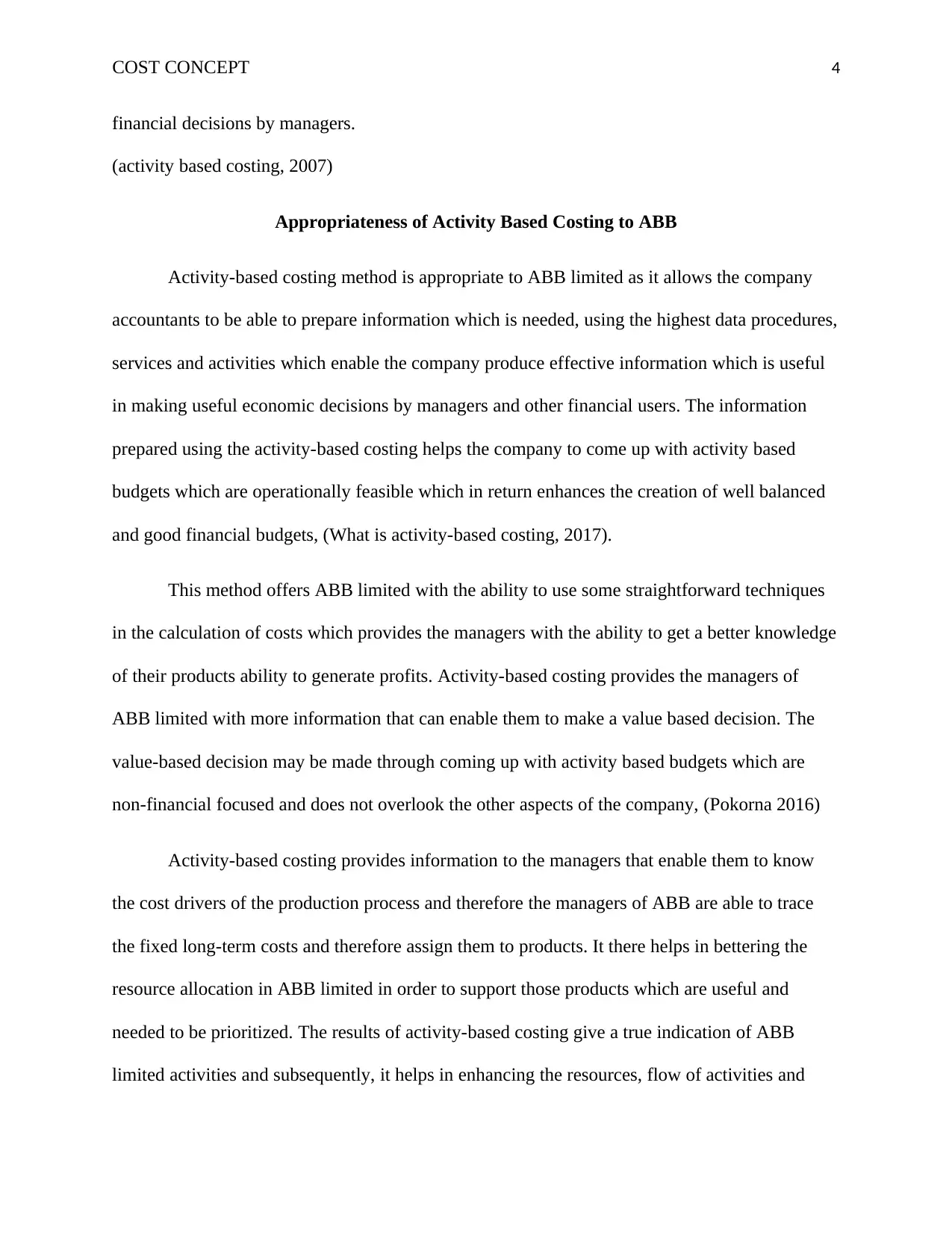
COST CONCEPT 4
financial decisions by managers.
(activity based costing, 2007)
Appropriateness of Activity Based Costing to ABB
Activity-based costing method is appropriate to ABB limited as it allows the company
accountants to be able to prepare information which is needed, using the highest data procedures,
services and activities which enable the company produce effective information which is useful
in making useful economic decisions by managers and other financial users. The information
prepared using the activity-based costing helps the company to come up with activity based
budgets which are operationally feasible which in return enhances the creation of well balanced
and good financial budgets, (What is activity-based costing, 2017).
This method offers ABB limited with the ability to use some straightforward techniques
in the calculation of costs which provides the managers with the ability to get a better knowledge
of their products ability to generate profits. Activity-based costing provides the managers of
ABB limited with more information that can enable them to make a value based decision. The
value-based decision may be made through coming up with activity based budgets which are
non-financial focused and does not overlook the other aspects of the company, (Pokorna 2016)
Activity-based costing provides information to the managers that enable them to know
the cost drivers of the production process and therefore the managers of ABB are able to trace
the fixed long-term costs and therefore assign them to products. It there helps in bettering the
resource allocation in ABB limited in order to support those products which are useful and
needed to be prioritized. The results of activity-based costing give a true indication of ABB
limited activities and subsequently, it helps in enhancing the resources, flow of activities and
financial decisions by managers.
(activity based costing, 2007)
Appropriateness of Activity Based Costing to ABB
Activity-based costing method is appropriate to ABB limited as it allows the company
accountants to be able to prepare information which is needed, using the highest data procedures,
services and activities which enable the company produce effective information which is useful
in making useful economic decisions by managers and other financial users. The information
prepared using the activity-based costing helps the company to come up with activity based
budgets which are operationally feasible which in return enhances the creation of well balanced
and good financial budgets, (What is activity-based costing, 2017).
This method offers ABB limited with the ability to use some straightforward techniques
in the calculation of costs which provides the managers with the ability to get a better knowledge
of their products ability to generate profits. Activity-based costing provides the managers of
ABB limited with more information that can enable them to make a value based decision. The
value-based decision may be made through coming up with activity based budgets which are
non-financial focused and does not overlook the other aspects of the company, (Pokorna 2016)
Activity-based costing provides information to the managers that enable them to know
the cost drivers of the production process and therefore the managers of ABB are able to trace
the fixed long-term costs and therefore assign them to products. It there helps in bettering the
resource allocation in ABB limited in order to support those products which are useful and
needed to be prioritized. The results of activity-based costing give a true indication of ABB
limited activities and subsequently, it helps in enhancing the resources, flow of activities and
Paraphrase This Document
Need a fresh take? Get an instant paraphrase of this document with our AI Paraphraser
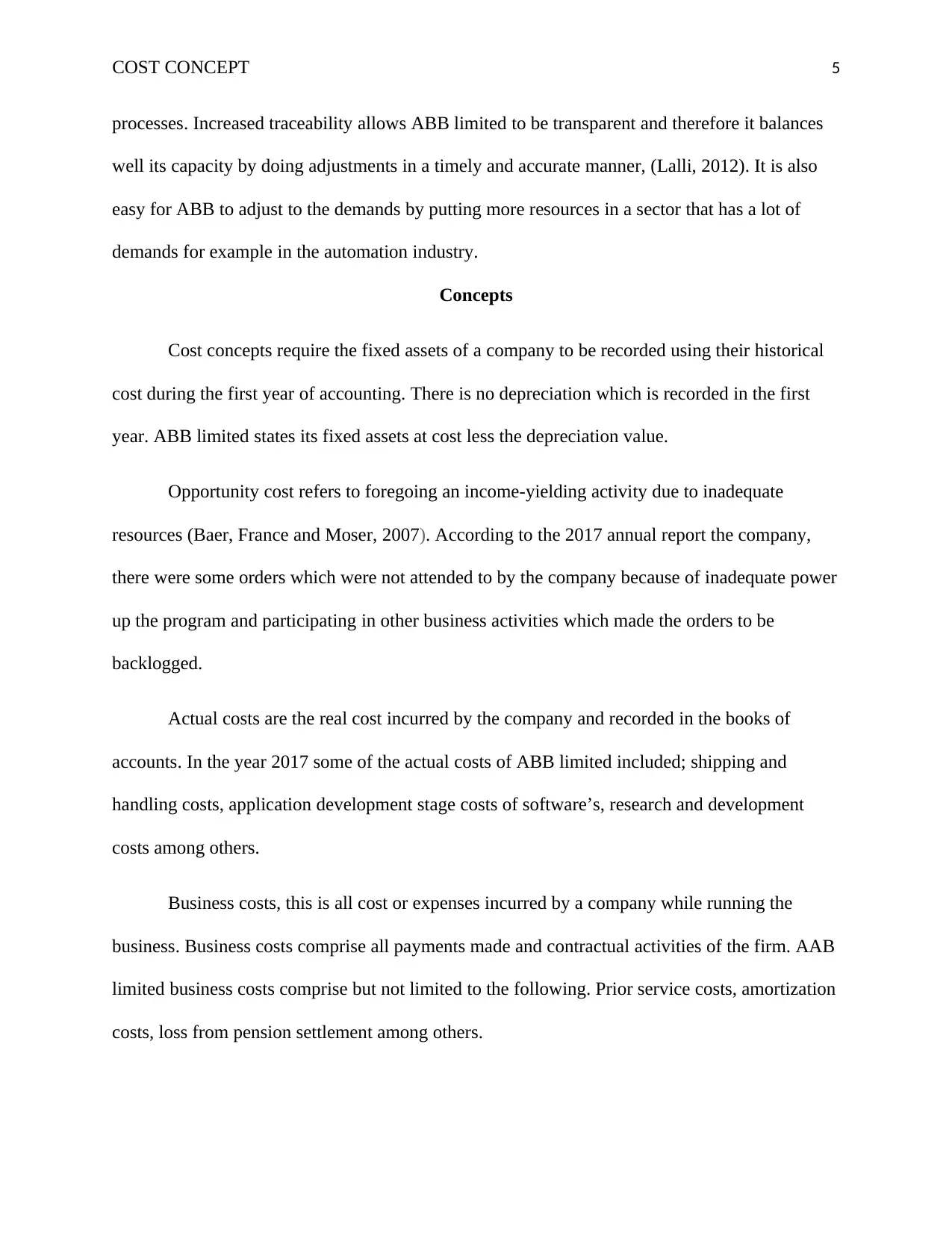
COST CONCEPT 5
processes. Increased traceability allows ABB limited to be transparent and therefore it balances
well its capacity by doing adjustments in a timely and accurate manner, (Lalli, 2012). It is also
easy for ABB to adjust to the demands by putting more resources in a sector that has a lot of
demands for example in the automation industry.
Concepts
Cost concepts require the fixed assets of a company to be recorded using their historical
cost during the first year of accounting. There is no depreciation which is recorded in the first
year. ABB limited states its fixed assets at cost less the depreciation value.
Opportunity cost refers to foregoing an income-yielding activity due to inadequate
resources (Baer, France and Moser, 2007). According to the 2017 annual report the company,
there were some orders which were not attended to by the company because of inadequate power
up the program and participating in other business activities which made the orders to be
backlogged.
Actual costs are the real cost incurred by the company and recorded in the books of
accounts. In the year 2017 some of the actual costs of ABB limited included; shipping and
handling costs, application development stage costs of software’s, research and development
costs among others.
Business costs, this is all cost or expenses incurred by a company while running the
business. Business costs comprise all payments made and contractual activities of the firm. AAB
limited business costs comprise but not limited to the following. Prior service costs, amortization
costs, loss from pension settlement among others.
processes. Increased traceability allows ABB limited to be transparent and therefore it balances
well its capacity by doing adjustments in a timely and accurate manner, (Lalli, 2012). It is also
easy for ABB to adjust to the demands by putting more resources in a sector that has a lot of
demands for example in the automation industry.
Concepts
Cost concepts require the fixed assets of a company to be recorded using their historical
cost during the first year of accounting. There is no depreciation which is recorded in the first
year. ABB limited states its fixed assets at cost less the depreciation value.
Opportunity cost refers to foregoing an income-yielding activity due to inadequate
resources (Baer, France and Moser, 2007). According to the 2017 annual report the company,
there were some orders which were not attended to by the company because of inadequate power
up the program and participating in other business activities which made the orders to be
backlogged.
Actual costs are the real cost incurred by the company and recorded in the books of
accounts. In the year 2017 some of the actual costs of ABB limited included; shipping and
handling costs, application development stage costs of software’s, research and development
costs among others.
Business costs, this is all cost or expenses incurred by a company while running the
business. Business costs comprise all payments made and contractual activities of the firm. AAB
limited business costs comprise but not limited to the following. Prior service costs, amortization
costs, loss from pension settlement among others.
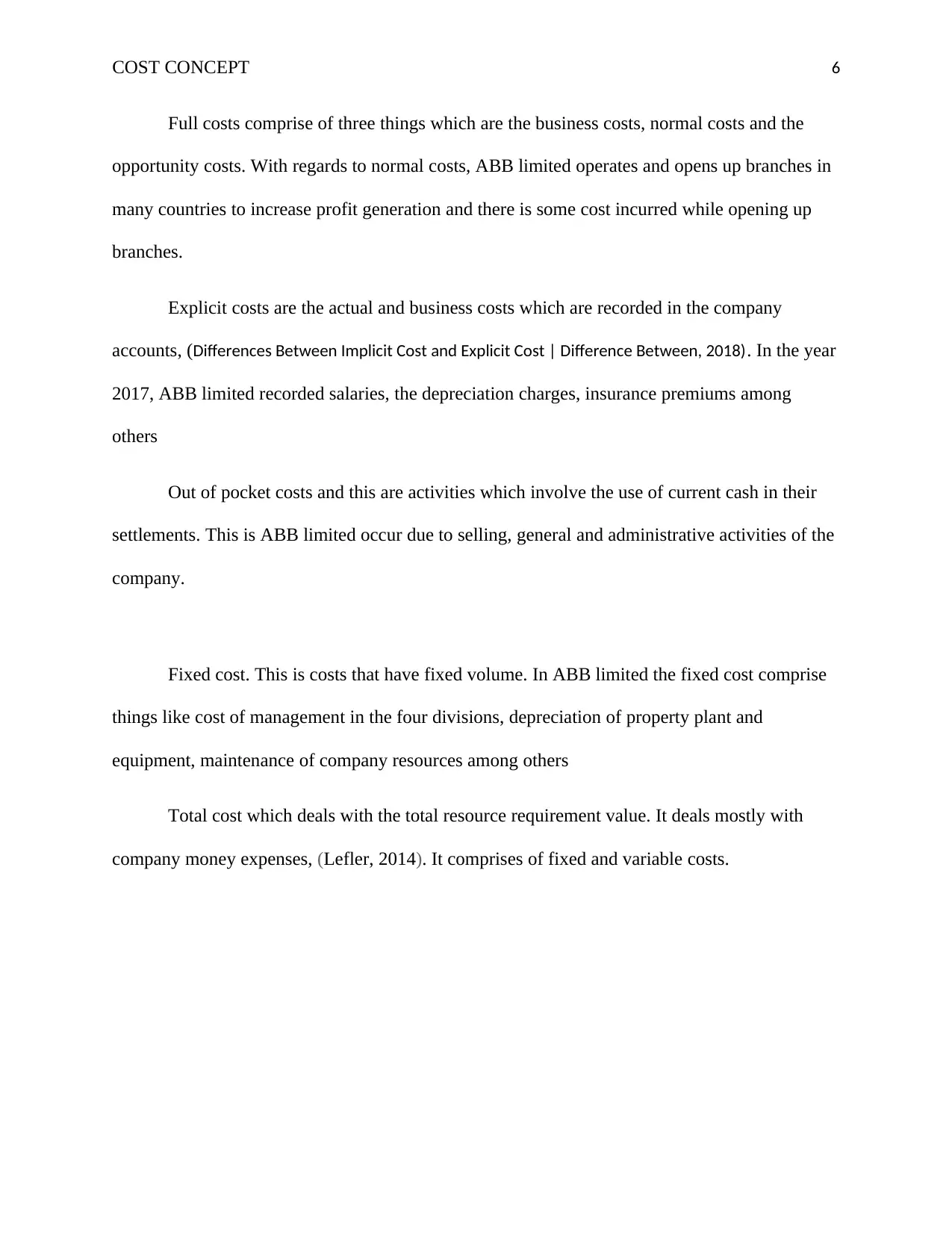
COST CONCEPT 6
Full costs comprise of three things which are the business costs, normal costs and the
opportunity costs. With regards to normal costs, ABB limited operates and opens up branches in
many countries to increase profit generation and there is some cost incurred while opening up
branches.
Explicit costs are the actual and business costs which are recorded in the company
accounts, (Differences Between Implicit Cost and Explicit Cost | Difference Between, 2018). In the year
2017, ABB limited recorded salaries, the depreciation charges, insurance premiums among
others
Out of pocket costs and this are activities which involve the use of current cash in their
settlements. This is ABB limited occur due to selling, general and administrative activities of the
company.
Fixed cost. This is costs that have fixed volume. In ABB limited the fixed cost comprise
things like cost of management in the four divisions, depreciation of property plant and
equipment, maintenance of company resources among others
Total cost which deals with the total resource requirement value. It deals mostly with
company money expenses, (Lefler, 2014). It comprises of fixed and variable costs.
Full costs comprise of three things which are the business costs, normal costs and the
opportunity costs. With regards to normal costs, ABB limited operates and opens up branches in
many countries to increase profit generation and there is some cost incurred while opening up
branches.
Explicit costs are the actual and business costs which are recorded in the company
accounts, (Differences Between Implicit Cost and Explicit Cost | Difference Between, 2018). In the year
2017, ABB limited recorded salaries, the depreciation charges, insurance premiums among
others
Out of pocket costs and this are activities which involve the use of current cash in their
settlements. This is ABB limited occur due to selling, general and administrative activities of the
company.
Fixed cost. This is costs that have fixed volume. In ABB limited the fixed cost comprise
things like cost of management in the four divisions, depreciation of property plant and
equipment, maintenance of company resources among others
Total cost which deals with the total resource requirement value. It deals mostly with
company money expenses, (Lefler, 2014). It comprises of fixed and variable costs.
⊘ This is a preview!⊘
Do you want full access?
Subscribe today to unlock all pages.

Trusted by 1+ million students worldwide
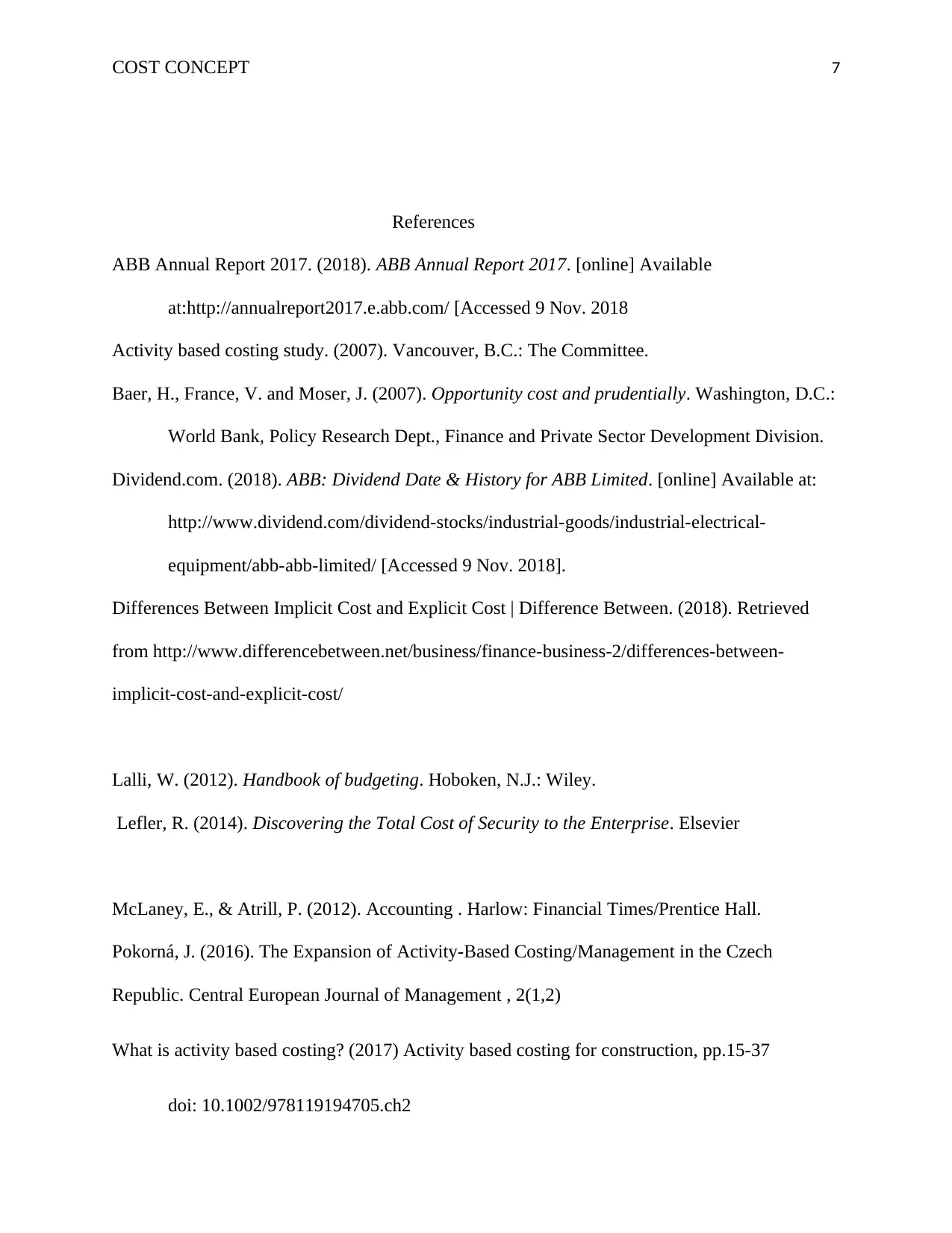
COST CONCEPT 7
References
ABB Annual Report 2017. (2018). ABB Annual Report 2017. [online] Available
at:http://annualreport2017.e.abb.com/ [Accessed 9 Nov. 2018
Activity based costing study. (2007). Vancouver, B.C.: The Committee.
Baer, H., France, V. and Moser, J. (2007). Opportunity cost and prudentially. Washington, D.C.:
World Bank, Policy Research Dept., Finance and Private Sector Development Division.
Dividend.com. (2018). ABB: Dividend Date & History for ABB Limited. [online] Available at:
http://www.dividend.com/dividend-stocks/industrial-goods/industrial-electrical-
equipment/abb-abb-limited/ [Accessed 9 Nov. 2018].
Differences Between Implicit Cost and Explicit Cost | Difference Between. (2018). Retrieved
from http://www.differencebetween.net/business/finance-business-2/differences-between-
implicit-cost-and-explicit-cost/
Lalli, W. (2012). Handbook of budgeting. Hoboken, N.J.: Wiley.
Lefler, R. (2014). Discovering the Total Cost of Security to the Enterprise. Elsevier
McLaney, E., & Atrill, P. (2012). Accounting . Harlow: Financial Times/Prentice Hall.
Pokorná, J. (2016). The Expansion of Activity-Based Costing/Management in the Czech
Republic. Central European Journal of Management , 2(1,2)
What is activity based costing? (2017) Activity based costing for construction, pp.15-37
doi: 10.1002/978119194705.ch2
References
ABB Annual Report 2017. (2018). ABB Annual Report 2017. [online] Available
at:http://annualreport2017.e.abb.com/ [Accessed 9 Nov. 2018
Activity based costing study. (2007). Vancouver, B.C.: The Committee.
Baer, H., France, V. and Moser, J. (2007). Opportunity cost and prudentially. Washington, D.C.:
World Bank, Policy Research Dept., Finance and Private Sector Development Division.
Dividend.com. (2018). ABB: Dividend Date & History for ABB Limited. [online] Available at:
http://www.dividend.com/dividend-stocks/industrial-goods/industrial-electrical-
equipment/abb-abb-limited/ [Accessed 9 Nov. 2018].
Differences Between Implicit Cost and Explicit Cost | Difference Between. (2018). Retrieved
from http://www.differencebetween.net/business/finance-business-2/differences-between-
implicit-cost-and-explicit-cost/
Lalli, W. (2012). Handbook of budgeting. Hoboken, N.J.: Wiley.
Lefler, R. (2014). Discovering the Total Cost of Security to the Enterprise. Elsevier
McLaney, E., & Atrill, P. (2012). Accounting . Harlow: Financial Times/Prentice Hall.
Pokorná, J. (2016). The Expansion of Activity-Based Costing/Management in the Czech
Republic. Central European Journal of Management , 2(1,2)
What is activity based costing? (2017) Activity based costing for construction, pp.15-37
doi: 10.1002/978119194705.ch2
Paraphrase This Document
Need a fresh take? Get an instant paraphrase of this document with our AI Paraphraser

COST CONCEPT 8
1 out of 8
Related Documents
Your All-in-One AI-Powered Toolkit for Academic Success.
+13062052269
info@desklib.com
Available 24*7 on WhatsApp / Email
![[object Object]](/_next/static/media/star-bottom.7253800d.svg)
Unlock your academic potential
Copyright © 2020–2025 A2Z Services. All Rights Reserved. Developed and managed by ZUCOL.



